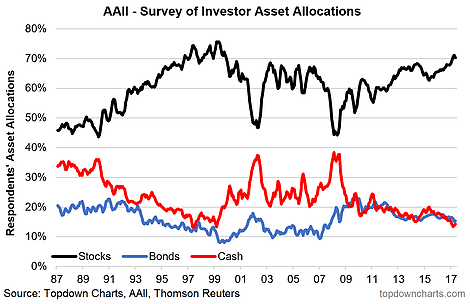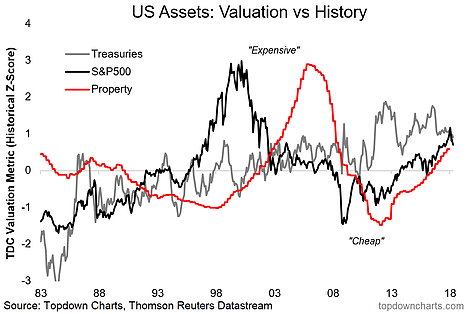This article looks at a couple of key trends in asset allocation. We look at the evolution of investor portfolio allocations to stocks, bonds, and cash both across time, and more recently. Importantly, we look at how it ties into the valuation picture against the backdrop of a coming full circle in the global monetary policy experiment. It seems for investors a brave new world is upon us as we move into a more challenging phase of the cycle.
The key takeaways on the trends (and challenges) in asset allocation are:
-Cash allocations are at almost 20-year lows, which is typically something you see later in the cycle.
-Equity allocations have drifted up at the expensive of cash and bond allocations.
-From the 80's to the 90's we saw what looks like a structural shift in portfolio allocations.
-With the major asset classes all looking expensive, and central banks moving into quantitative tightening, it's a brave new world for asset allocators.
1. Cash Allocations: As regular readers will know, I've talked about this chart a lot and I think it does capture a few key issues. It also serves to highlight or contrast with the rest of the charts in this article, particularly the one on valuations at the end. Firstly, for clarity the chart shows surveyed cash allocations across individual investors in America (the AAII survey), and implied allocations (derived from ICI mutual fund statistics). They both say basically the same thing: that cash allocations are near record lows, certainly at a cycle low. Investors have been both drifted out of cash (drift = changes in asset allocation driven by market movement), and basically bullied out of cash by central banks. And as I implied, there is a cyclical element to it - this is usually the type of condition you'd see toward the later stages of the market cycle.

2. AAII Portfolio Allocation Survey: Delving deeper into the AAII survey, the chart below shows the allocations across stocks, bonds, and cash. Interestingly there was a big rotation out of cash and into bonds around 2008-09 – no doubt some substituting of zero-rate cash into the relatively attractive yields of bonds (it was a different story when cash was earning 5.25% and US 10-year yields were in the high 4's... compared to when cash was earning 0 and 10-year treasuries were yielding in the high 3's in the years immediately after the crisis). But going back to the concept of drift, there has been a steady down-weighting to bonds and cash in favor of equities. Portfolio drift is inherently a passive concept, yet as I often note, many "passive" constructs in investing are actually active decisions in disguise.
For instance, the mere act of allowing portfolio allocations to drift is effectively an active decision to continue to overweight assets which have done better and down-weight assets which have done worse. In other words, the decision not to rebalance is an active decision. And going slightly further on this tangent, passive equity exposure is basically saying "my strategy is to hold the largest companies" (at least in the case of market-cap weighted indexes). So that's something to consider – are your passive or default decisions actually an active decision?

3. ICI Mutual Fund Data – Implied Allocations: Taking a slightly different approach in this chart, what I have done is calculate "implied allocations" by dividing each bucket of mutual fund AUM (assets under management) by total mutual fund assets. The results are more or less in line, at least stylistically, versus the AAII survey. The same rotation from cash to bonds can be seen, and the same dynamic of progressively higher equity allocations can also be seen. But one step further – you can also see what appears to be a sort of structural change in asset allocation from the late-80's to the late-90's.
Going back to the yields aspect, in the late 1980's you could find 8%+ yields in cash and bonds without going out the risk curve at all (e.g. in 1985 the Fed funds rate was some 8.25% vs almost 12% on US 10-year government bonds). So even without factoring in the equity risk premium (which peaked around 11% in 1982), or earnings yield (close to 10% in 1985), with such high absolute returns available risk-free it's not hard to see why for many the easy or "passive" decision was just to run high bond and cash allocations. And again, in the 1990's it was probably just as much portfolio drift as it was active allocation which drove the shift.

4. Major Asset Class Valuations: Since we've been talking about the 1980's, it's actually quite interesting to contrast the 1980's with the current valuation backdrop. In the early 1980's both stocks and bonds were showing up on the cheap end of our valuation signals. Contrast that to the current picture, where the valuation conundrum for asset allocators is increasingly expensive valuations across all of the major asset classes. On our valuation metrics stocks, bonds, and property are all showing up around 1 standard deviation expensive.
As I talked about in a recent presentation on the Global Risk Radar, the contrarian minded allocator might be tempted to look at this chart along side the cash allocations chart from the start and act accordingly. Of course, the glass-half-full type may look at the chart and point out that while property and stocks look expensive, they're yet to scale the heights of either the late-90's or mid-2000's. Either way, with global central banks transitioning away from quantitative easing to quantitative tightening, it's a brave new world for investors.

